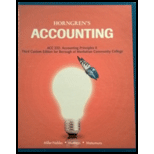
Concept Introduction:
TQM:
TQM stands for total quality management. TQM focuses on the overall quality of the product. It focuses on providing high product to the customers with the least defect possible. So that the confidence of the customers over the company and the product can be gained, that will overall benefit the business.
E-Commerce:
E-Commerce can be defined as the business done through internet i.e. goods are purchased and sold, services are provided through internet all over the world.
Triple Bottom Line:
Triple Bottom Line can be defined as the concept which focuses on including social and environmental factors to be considered along with the economic factors of the business, thus, it is termed as triple bottom line.
ERP (Enterprise Resource Planning):
ERPs are the software programmes designed as per the needs and the requirements of the business. It can be defined as a programme that combines all the operational activities and coordinate all of them together.
JIT (Just In Time):
JIT can be defined as the concept which focuses on the keeping only required amount of inventory as per the current demand.
To match:
Definitions:
1. A philosophy designed to integrate all organizational areas in order to provide customers with superior products and services while meeting organizational objectives. Require improving quality and eliminating defects and waste.
2. Use of the internet for business functions such as sales and customers service. Enables companies to reach customers around the world.
3. Evaluating a company’s performance by its economic, social and environmental impact.
4. Software System that integrates all of a company’s functions, departments, and data into a single system.
5. A System in which a company produces products just when they are needed to satisfy needs. Suppliers deliver materials when they are needed to begin production, and finished units are completed at the right time for delivery to customers.
With terms:
a. ERP
b. JIT
c. E-commerce
d. TQM
e. Triple Bottom Line.
Want to see the full answer?
Check out a sample textbook solution
Chapter 18 Solutions
ACCOUNTING PRINCIPLES 222 5/16 >C<
- How many units were completed?arrow_forwardIn the month of September, a department had 9,500 units in beginning work in process that were 60% complete. During September, 28,500 units were transferred into production from another department. At the end of September, there were 5,500 units in ending work in process that were 50% complete. Materials are added at the beginning of the process, while conversion costs are incurred uniformly throughout the process. A. The equivalent units of production for materials in September were __. B. The equivalent units of production for conversion costs for September were __.arrow_forwardBurson Enterprises' May 31 bank reconciliation shows deposits in transit of $850. The general ledger Cash in Bank account shows total cash receipts during June of $48,500. The June bank statement shows total cash deposits of $44,300 (including $1,500 from the collection of a note; the note collection has not yet been recorded by Burson). What amount of deposits in transit should appear in the June 30 bank reconciliation?arrow_forward
- Job 528 was one of the many jobs started and completed during the year. The job required $11,200 in direct materials and 40 hours of direct labor time at a total direct labor cost of $12,600. If the job contained five units and the company billed at 65% above the unit product cost on the job cost sheet, what price per unit would have been charged to the customer?arrow_forwardCalculate the net cash provided by operating activities of this financial accounting questionarrow_forwardgiven answer of this General accounting questionarrow_forward
- Burson Enterprises' May 31 bank reconciliation shows deposits in transit of $850. The general ledger Cash in Bank account shows total cash receipts during June of $48,500. The June bank statement shows total cash deposits of $44,300 (including $1,500 from the collection of a note; the note collection has not yet been recorded by Burson). What amount of deposits in transit should appear in the June 30 bank reconciliation? Helparrow_forwardWhat should be the adjusted cash balancearrow_forwardHii, tutor give me Answerarrow_forward

 AccountingAccountingISBN:9781337272094Author:WARREN, Carl S., Reeve, James M., Duchac, Jonathan E.Publisher:Cengage Learning,
AccountingAccountingISBN:9781337272094Author:WARREN, Carl S., Reeve, James M., Duchac, Jonathan E.Publisher:Cengage Learning, Accounting Information SystemsAccountingISBN:9781337619202Author:Hall, James A.Publisher:Cengage Learning,
Accounting Information SystemsAccountingISBN:9781337619202Author:Hall, James A.Publisher:Cengage Learning, Horngren's Cost Accounting: A Managerial Emphasis...AccountingISBN:9780134475585Author:Srikant M. Datar, Madhav V. RajanPublisher:PEARSON
Horngren's Cost Accounting: A Managerial Emphasis...AccountingISBN:9780134475585Author:Srikant M. Datar, Madhav V. RajanPublisher:PEARSON Intermediate AccountingAccountingISBN:9781259722660Author:J. David Spiceland, Mark W. Nelson, Wayne M ThomasPublisher:McGraw-Hill Education
Intermediate AccountingAccountingISBN:9781259722660Author:J. David Spiceland, Mark W. Nelson, Wayne M ThomasPublisher:McGraw-Hill Education Financial and Managerial AccountingAccountingISBN:9781259726705Author:John J Wild, Ken W. Shaw, Barbara Chiappetta Fundamental Accounting PrinciplesPublisher:McGraw-Hill Education
Financial and Managerial AccountingAccountingISBN:9781259726705Author:John J Wild, Ken W. Shaw, Barbara Chiappetta Fundamental Accounting PrinciplesPublisher:McGraw-Hill Education





